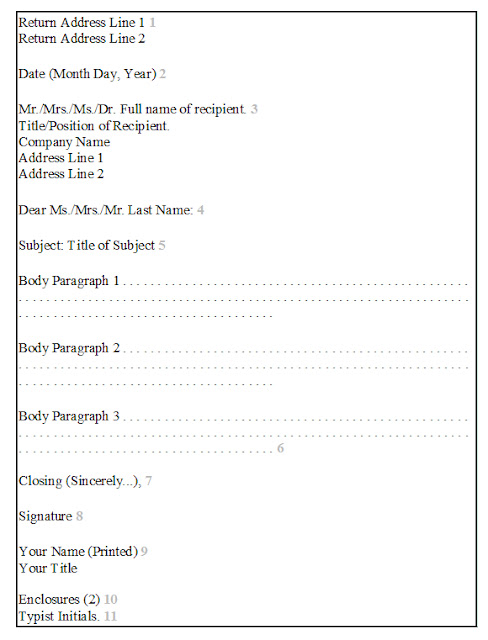Sometimes, when we want to write letters in English, we don’t know how to start, develop, or even end it. There are actually different kinds of letters. Here are some examples.
Business letters
When writing a complaint letter, you want to keep it short and to the point to help ensure that your letter will be read in its entirety. The complaint letter should be addressed to the customer service/consumer affairs department or the head office if there is no customer service department.
- Format:
Your Address 1
The return address of the sender so the recipient can easily find out where to send a reply to. Skip a line between your address and the date. (Not needed if the letter is printed on paper with the company letterhead already on it.)
Date 2
Put the date on which the letter was written in the format Month Day Year i.e. August 30, 2003. Skip a line between the date and the inside address (some people skip 3 or 4 lines after the date).
Inside Address 3
The address of the person you are writing to along with the name of the recipient, their title and company name, if you are not sure who the letter should be addressed to either leave it blank, but try to put in a title, i.e. "Director of Human Resources". Skip a line between the date and the salutation.
Salutation 4
Dear Ms./Mrs./Mr. Last Name:, Dear Director of Department Name: or To Whom It May Concern: if recipient's name is unknown. Note that there is a colon after the salutation. Skip a line between the salutation and the subject line or body.
Subject Line (optional) 5
Makes it easier for the recipient to find out what the letter is about. Skip a line between the subject line and the body.
Body 6
The body is where you write the content of the letter; the paragraphs should be single spaced with a skipped line between each paragraph. Skip a line between the end of the body and the closing.
Closing 7
Let's the reader know that you are finished with your letter; usually ends with Sincerely, Sincerely yours, Thank you, and so on. Note that there is a comma after the end of the closing and only the first word in the closing is capitalized. Skip 3-4 lines between the closing and the printed name, so that there is room for the signature.
Signature 8
Your signature will go in this section, usually signed in black or blue ink with a pen.
Printed Name 9
The printed version of your name, and if desired you can put your title or position on the line underneath it. Skip a line between the printed name and the enclosure.
Enclosure 10
If letter contains other document other than the letter itself your letter will include the word "Enclosure." If there is more than one you would type, "Enclosures (#)" with the # being the number of other documents enclosed, not including the letter itself.
Reference Initials 11
If someone other than yourself typed the letter you will include your initials in capital letters followed by the typist's initials in lower case in the following format; AG/gs or AG:gs.
- Sample:
Friendly letters
A friendly letter (or informal letter) is a way of communicating between two people (sometimes more) who are usually well acquainted. There are many uses and reasons for writing a friendly letter but friendly letters will usually consist of topics on a personal level. Friendly letters can either be printed or hand-written.
In the friendly letter format, your address, date, the closing, signature, and printed name are all indented to the right half of the page (how far you indent in is up to you as long as the heading and closing is lined up, use your own discretion and make sure it looks presentable). Also the first line of each paragraph is indented.
- Format:
Your Address 1
All that is needed is your street address on the first line and the city, state and zip on the second line. (Not needed if the letter is printed on paper with a letterhead already on it.)
Date 2
Put the date on which the letter was written in the format Month Day Year e.g. August 30, 2003. Skip a line between the date and the salutation.
Salutation 3
Usually starts out with Dear so and so, or Hi so and so. Note: There is a comma after the end of the salutation (you can use an exclamation point also if there is a need for some emphasis).
Body 4
The body is where you write the content of the letter; the paragraphs should be single spaced with a skipped line between each paragraph. Skip 2 lines between the end of the body and the closing.
Closing 5
Let's the reader know that you are finished with your letter; usually ends with Sincerely, Sincerely yours, Thank you, and so on. Note that there is a comma after the end of the closing and only the first word in the closing is capitalized.
Signature 6
Your signature will go in this section, usually signed in black or blue ink with a pen. Skip a line after your signature and the P.S.
P.S. 7
If you want to add anything additional to the letter you write a P.S. (post script) and the message after that. You can also add a P.P.S after that and a P.P.P.S. after that and so on.
- Sample:
Although I’ve elicited these two kinds of letters, there are others equally important. There are appealing letters, apology letters, interview thank you letters, etc. Do you want to know more?











